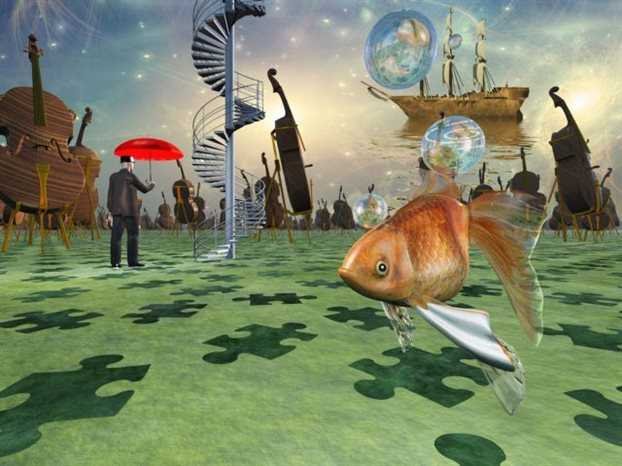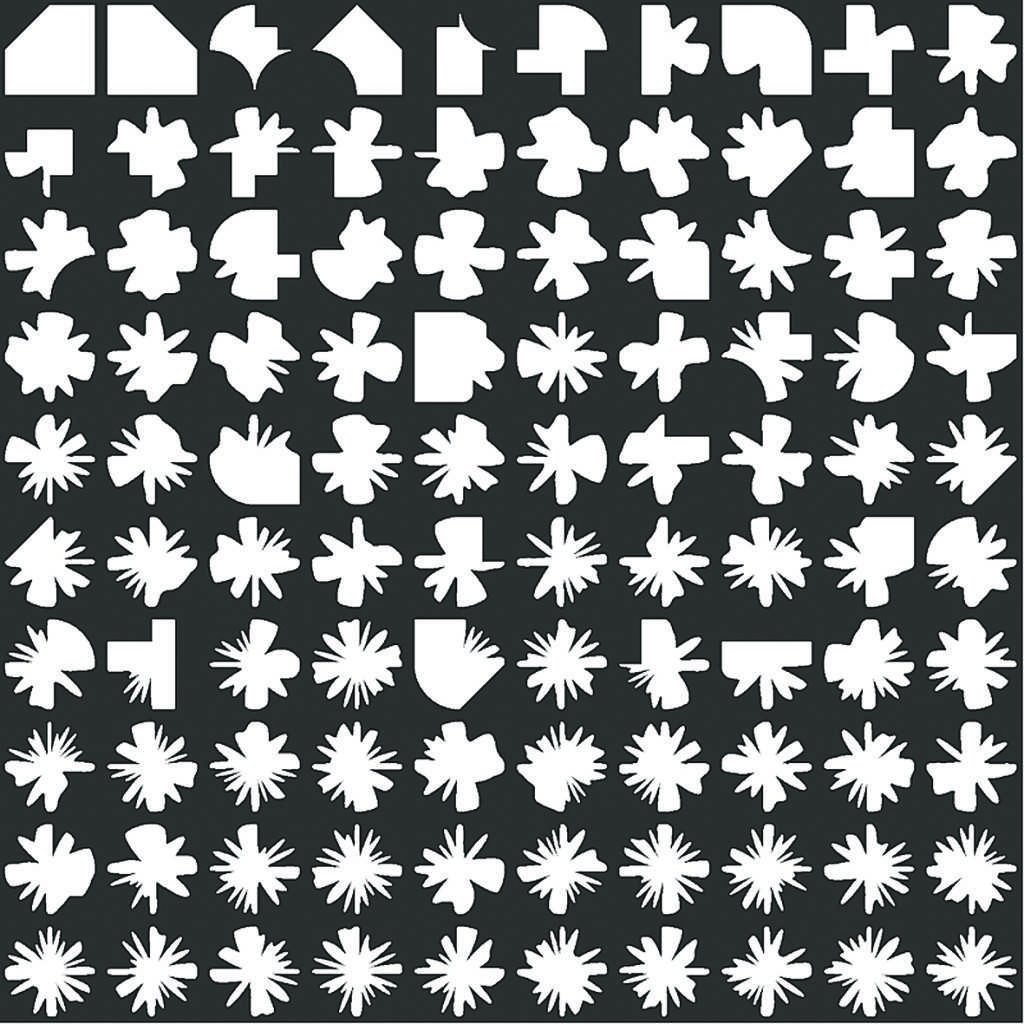Imagination is a "collective" work, as far as neurons in our brain are concerned. The scientists "saw" the network that is triggered when the imagination is being used, as well as the areas that act as "traffickers" of our attention

ΔΗΜΟΣΙΕΥΣΗ: 04/01/2014 05:45
The stepYou may think imagination is a gift that not all people have. If so, you are wrong. Even if you do not have the highly creative imagination of great writers and artists, it is certain that you use your imagination every day very often and creatively. Not only to "get away" in daydreams but also to perform many other "pedestrian" activities, such as to figure out your shopping account, find a way to prevent a door from blowing in the air, to "purge" a supposed conversation with your boss to ask for permission or raise or to think about what a friend would do in your place so you can do the same.
This "mental representation" that comes to you so naturally is in fact a quality that distinguishes humans from animals - or at least from most of them, as experts believe. It is therefore no coincidence that locating the "center" of the imagination in the human brain is one of the main goals of neuroscience research. Until recently, this goal seemed rather elusive, but recently a study by scientists at Dartmouth College in New Hampshire in the United States came to give the most "tangible" answer to this search. The researchers not only located a network of imagination in the brains of volunteers but also were able to "see", depending on the patterns of information flow, exactly how they used their imagination - in general, what they imagined. In addition to being impressive, their findings are also considered important because they offer strong support for a concept that has begun to prevail in recent years in the cognitive sciences and neuroscience about how our brains work.
What is “mental space work»
Ας πάρουμε όμως τα πράγματα με τη σειρά. Καθώς, εδώ και λίγες μόνο δεκαετίες, η εξερεύνηση του ανθρώπινου εγκεφάλου άρχισε να γίνεται όλο και πιο «βαθιά» χάρη στην πολύτιμη βοήθεια των νέων απεικονιστικών τεχνικών, οι επιστήμονες άρχισαν να εντοπίζουν διάφορα μεμονωμένα «κέντρα» και «περιοχές» που φαίνονταν να σχετίζονται με συγκεκριμένες
functions. Ετσι λοιπόν αρχίσαμε να μιλάμε π.χ. για το «κέντρο της όρασης» ή το «κέντρο της ανταμοιβής» και ούτω καθεξής. Με το πέρασμα του χρόνου όμως και καθώς οι μελέτες και οι γνώσεις εμπλουτίζονταν οι ειδικοί άρχισαν να καταλήγουν στο συμπέρασμα ότι τουλάχιστον οι πιο σύνθετες, ανώτερες λειτουργίες του εγκεφάλου – όπως η επιστημονική, μαθηματική και καλλιτεχνική σκέψη ή η φαντασία – δεν μπορεί να εκτελούνται σε μεμονωμένα κέντρα αλλά απαιτούν τη συνεργασία περισσότερων περιοχών.
Thus was born the theory of the so-called "mental workspace", an expanded neural network that combines and processes
information – images, symbols, memories and other mental constructs – originating from different 'centres' of the brain. Although this theory sounds perfectly reasonable, the existence of this neural network has not yet found its full scientific proof. The main obstacle to its detection is posed by the fact that the methods used in the studies of the species focus on the brain activity at individual points and are not able to "capture" the processes of information distribution in the brain networks.

The brain imaging of the researchers shows that almost the whole brain is triggered for imagination
Recently, however, with the application of new techniques, some studies have begun to identify data which advocate the mental workplace theory. The work of the scientists from Dartmouth College is considered to be a particularly important step in this effort as it comes to "snap" with previous studies, offering the most "hands-on" proof that has been found to date. "Our study is part of an expanding array of elements, we are not the first to find any evidence that the mental workplace exists, but our work together with others begins to outline it" he says in "Vima" Alex Schlegel, a PhD student in cognitive sciences at Dartmouth College and lead author of the relevant article published in the "Proceedings of the National Academy of Sciences" review. "We had some ideas that the brain should have some kind of system to handle the mental representation of things with flexibility. But our findings, coupled with a number of other elements, begin to show for the first time how the brain can do so, the neural networks that are involved in such a function ".
They captured the imagination… instantly
The innovation of the Dartmouth researchers is that they were able for the first time to see the imagination in action in real time in the brains of volunteers and to show that, in order to "give birth" to mental representation, different areas communicated with each other in an expanded network. They even found that the communication between the areas changed depending on the type of mental representation that the volunteers engaged in - that is, they saw that they could understand what the volunteers imagined just by looking at the pattern of communication between the different areas of the network!
But to get there they had to carefully plan their experiments. "You know, we're all very interested in these mysterious behaviors like imagination and creativity - what makes an artist an artist, for example. But in order to approach these issues scientifically, you have to set many checklists and make things as simple as possible. " says Mr. Schlegel. For this reason, scientists chose to ask volunteers to perform three different "imaging works" as they call it. By excluding the acoustic stimuli in the laboratory and allowing only visuals, they showed volunteers a series of patterns they had designed themselves that could be synthesized into more complex imagery or "decomposed" to give simpler shapes.
The experiment
 A series of shapes that had to remember, synthesize and disintegrate the volunteers
A series of shapes that had to remember, synthesize and disintegrate the volunteersIn the first project, the volunteers saw a shape for eight seconds and later had to distinguish it between four different shapes - a simple functional memory test, which requires the mental representation of an image. In the other two projects the volunteers saw some shapes again for eight seconds and later had to either put them together to make another shape or disassemble them into smaller pieces - think of something like trying to imagine a dog with a head lion or a headless rider, both images require either assembling other images you retrieve from your memory or disassembling them.
"These two works required images to be processed after they had been formed in mind" the investigator explains.
"In essence what we did have two different functions of the mental representation. And the question was: can we see when a person assembled or disassembled an image based on brain activity? And what are the areas involved in these projects? "
As scientists saw, both of these functions were not the work of some individual sites but of an entire network. "This was very interesting, that it was not just one or two parts of the brain that seemed to be involved in these functions but a network that seemed to spread across the brain" says Mr. Schlegel. "And not only that, but in some subsets of this network we could see, we could really tell from the pattern of information flow whether a person was assembling or disassembling an image. You know, the press says about these techniques that they "read the mind." Well, we did something like that with the techniques we used ". In addition, the scientists found that the way the involved areas were connected to each other - the "connectivity" pattern - was different from the other two when the volunteers simply retrieved an image from their memory in the first simple functional memory test.
How is attention directed?
Although the mental workplace network seemed to spread across the brain, some areas seemed to be particularly involved in it. These were the frontal pre-frontal cortex and the posterior parietal cortex, two areas constituting the so-called "frontal parietal network," which is associated with higher cognitive functions such as functional memory, mathematical computations, or analogue reasoning. "One is in the frontal lobe, in the front of the brain and the other in the parietal lobe, backwards" explains Mr. Schlegel. "Too many studies are exploring these areas and we are beginning to understand what they specialize in". The parietal cortex is related to attention, that is, which parts of one's experience one pays attention to, while the prefrontal cortex is related to the direction of the brain - it directs attention, functional memory and many different functions and behaviors, as the scientist explains. "It seems that the frontal-parietal network is particularly involved in the flexibility of the direction of attention, sometimes it directs our attention to external stimuli, sometimes it directs it towards our inner world, the images of our mind or the functional memory".
Mysterious and admired "everyday" human qualities
The ability of the human brain to create stories and images and to "travel" to different places is unique but also "awkward" for scientists. “We don't know, we still don't know enough about it, the real core of how the brain does this kind of thing eludes us. But if you think about your own experience alone, this is something that really happens, and it happens all the time." says Alex Schlegel, adding that many different individual properties are involved in this function. One of these, as he stresses, is our ability to make comparisons and transfers. "Let's say I'm a composer of classical music and I think about my composition" he explains"I want to give, for example, the feeling that a wolf enters the scene and, to do that, I can bring to my mind pictures of the wolf and connect them with sounds that I still retrieve from my memory to make a parallel ".
This, the researcher points out, shows beyond any doubt that the human brain has the ability to move with tremendous flexibility to arrive at a kind of common language or common representation of all things - a property also distinct. "It can unite different elements and extract similarities, proportions between them. Analog reasoning is at the core of the features that make people unique " he stresses. "We say that someone is stretching his hands like an eagle, we can see common qualities in things that apparently have nothing to do with each other. And this is unique ".
Join the 2.086 registrants.








